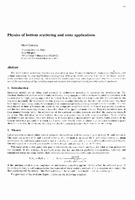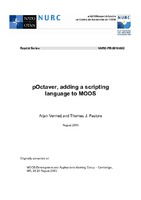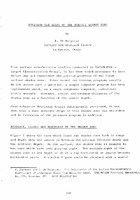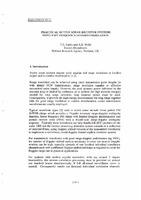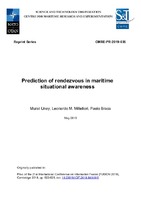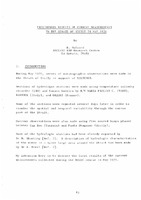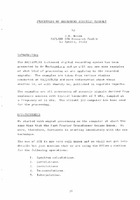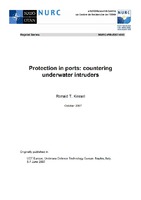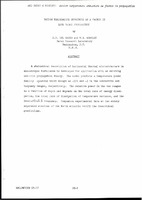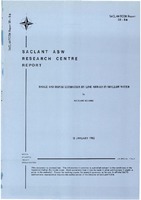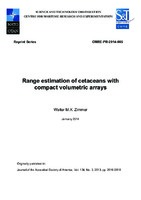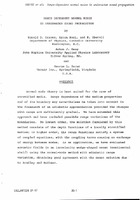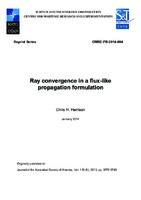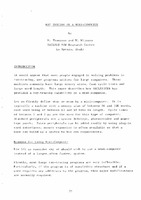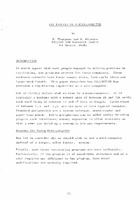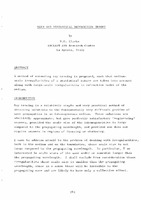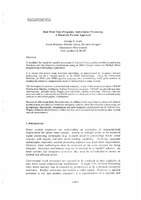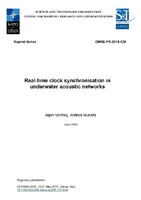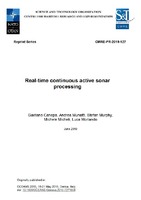Browsing Reprints by Title
Now showing items 370-389 of 548
-
Physics of bottom scattering and some applications
(NATO. SACLANTCEN, 1997)The main bottom scattering theories are described in their bistatic formulation: composite-roughness, and volume scattering. Several applications are proposed. One of the main concerns is to check the mono- and bisfafic ... -
pOctaver, adding scripting language to MOOS
(NURC, 2010/08)NURC uses MOOS-IvP in a scientific research and rapid prototyping environment. Contributions to the open-source suite of MOOS-IvP software is readily made by programmers adept at C++ programming. However, the utility of ... -
Position and shape of the surface shadow zone
(NATO. SACLANTCEN, 1971/12)From surface reverberation studies conducted by SACLANTCEN's Target Classification Group"C , it has been found necessary to know before any sea experiment the precise position of the first surface shadow zone. Since normal ... -
Practical active sonar receiver systems using fast frequency-domain correlation
(NATO. SACLANTCEN, 1993/08) -
Prediction of rendezvous in maritime situational awareness
(CMRE, 2019/05)In this work, we consider the problem of algorithmically predicting rendezvous among vessels based on their trajectory forecasts in a maritime environment. The problem is treated as hypothesis testing on the expected value ... -
Preliminary results of current measurements in the Strait of Sicily in May 1970
(NATO. SACLANTCEN, 1972/09)During May 1970, series of oceanographic observations were made in the Strait of Sicily in support of MILOCMED. Sections of hydrologic stations were made using temperature salinity recorder (TDS) and Nansen bottles by R/ ... -
Processing of broadband acoustic signals
(NATO. SACLANTCEN, 1972/05) -
Propeller leading edge trimming and maintenance effects on ship's noise operational performance
(NATO. SACLANTCEN, 1985/01)In the last ten years, considerable experience has been gathered at CEIMM's cavitation tunnel (Centra Esperienze Idrodinamiche Marina Militare) on the effects of propeller leading edge geometry on cavitation (and noise) ... -
Protection in ports: countering underwater intruders
(NURC, 2007/10)The advance of new capability depends on many things: the state of the art in technology, the clarity of the mission and requirements, the knowledge of the threat, the means of response, and, for developers, the state of ... -
Random temperature structure as a factor in long-range propagation
(NATO. SACLANTCEN, 1975/10)A statistical description of horizontal thermal microstructure in anosotropic turbulence is developed for application with an existing acoustic propagation theory. The model predicts a temperature power density spectrum ... -
Range and depth estimation by line arrays in shallow water
(NATO. SACLANTCEN, 1982/01)In shallow water sound propagates in terms of normal modes. The interference between the modes can be utilized to estimate range and depth of an acoustic source in shallow water by applying high resolution power estimators ... -
Range estimation of cetaceans with compact volumetric arrays
(CMRE, 2014/01)Passive acoustic monitoring is the method of choice to detect whales and dolphins that are acoustically active and to monitor their underwater behaviour. The NATO Science and Technology Organization Centre for Maritime ... -
Range-dependent normal modes in underwater sound propagation
(NATO. SACLANTCEN, 1975/10)Normal mode theory is best suited for the case of stratified media. Range dependence of the medium properties and of its boundary may nevertheless be taken into account in the framework of an adiabatic approximation provided ... -
Ray convergence in a flux-like propagation formulation
(CMRE, 2014/01)The energy flux formulation of waveguide propagation is closely related to the incoherent mode sum, and its simplicity has led to development of efficient computational algorithms for reverberation and target echo strength, ... -
Ray tracing on a mini-computer
(NATO. SACLANTCEN, 1971/12)It would appear that most people engaged in solving problems in ray- tracing, use programs written for large computers . These machines commonly have large memory sizes, fast cycle times and large word length 0 This paper ... -
Ray tracing on a mini-computer
(NATO. SACLANTCEN, 1972/05)It would appear that most people engaged in solving problems in ray- tracing, use programs written for large computers. These machines commonly have large memory si~es, fast cycle times and large word length . This paper ... -
Rays and statistical diffraction theory
(NATO. SACLANTCEN, 1971/12)A method of extending ray tracing is proposed, such that mediumscale irregularities of a statistical nature are taken into account along with large-scale irregularities in refractive index of the medium. -
Real time-frequency active sonar processing: a massively parallel approach
(NATO. SACLANTCEN, 1993/08)A paradigm for massively parallel processing of matched filters, replica correlators, ambiguity functions and time-frequency distributions using an SIMD (Single Instruction Multiple Data) programming methodology is presented. ... -
Real-time clock synchronisation in underwater acoustic networks
(CMRE, 2019/06)This paper proposes an algorithm for real-time clock synchronisation in underwater acoustic networks. The algorithm models modem clocks as linear functions and embeds the data necessary for the clock synchronisation procedure ... -
Real-time continuous active sonar processing
(CMRE, 2019/06)This work describes the development of continuous active sonar (CAS) processing at CMRE. The software uses subband processing to achieve a faster update rate than is possible with pulsed active sonar (PAS). The software ...
